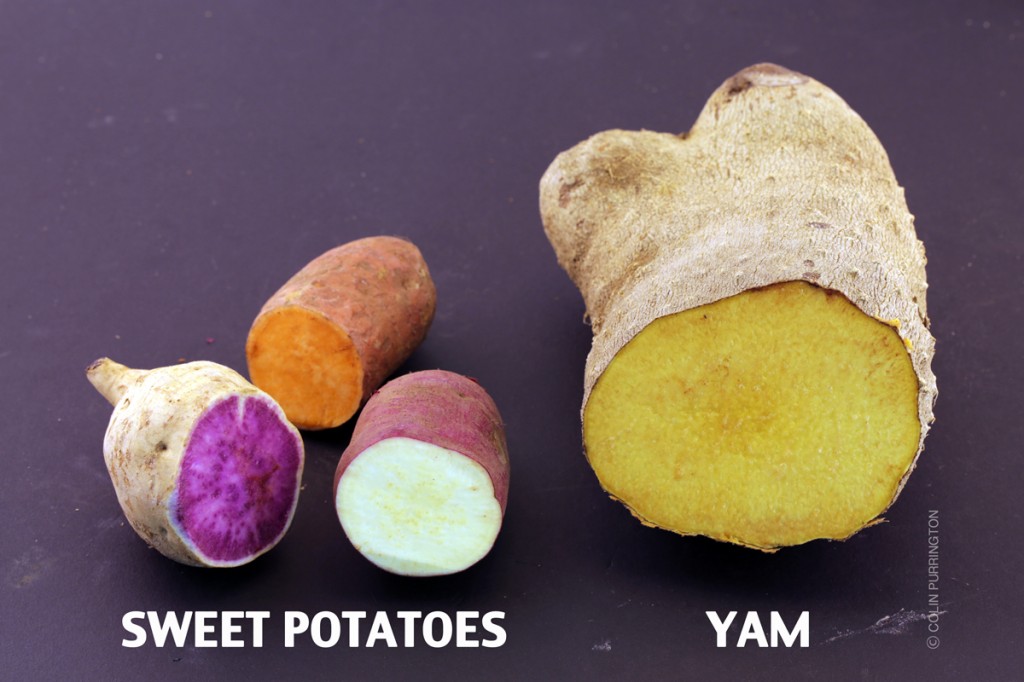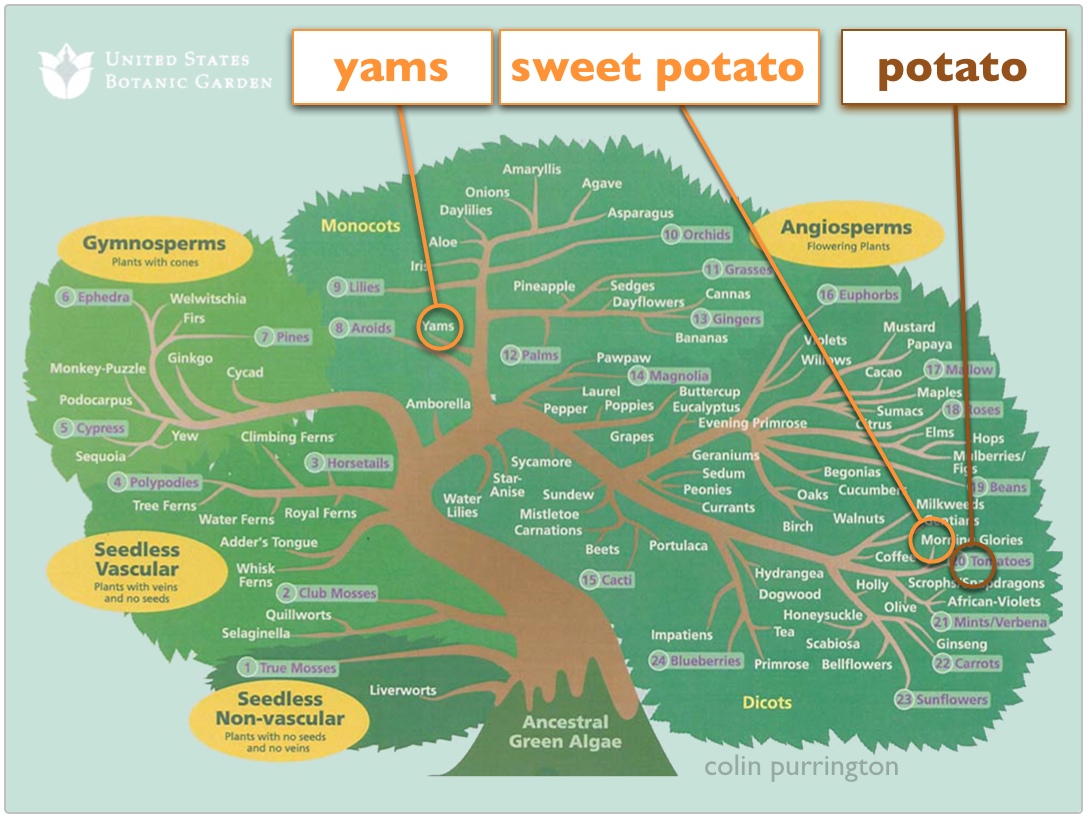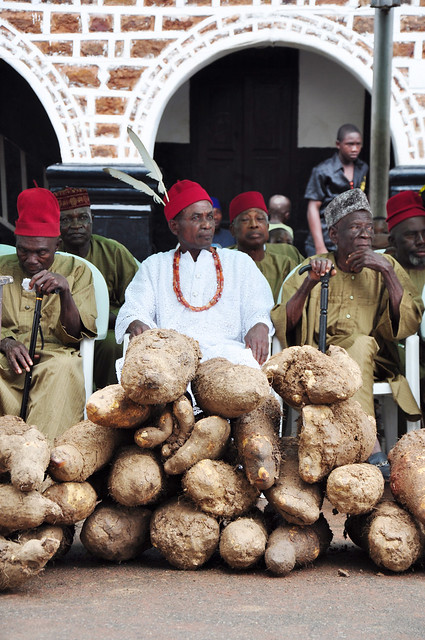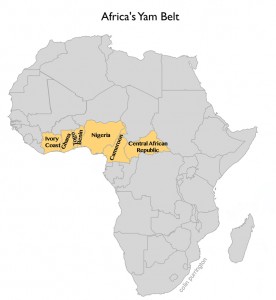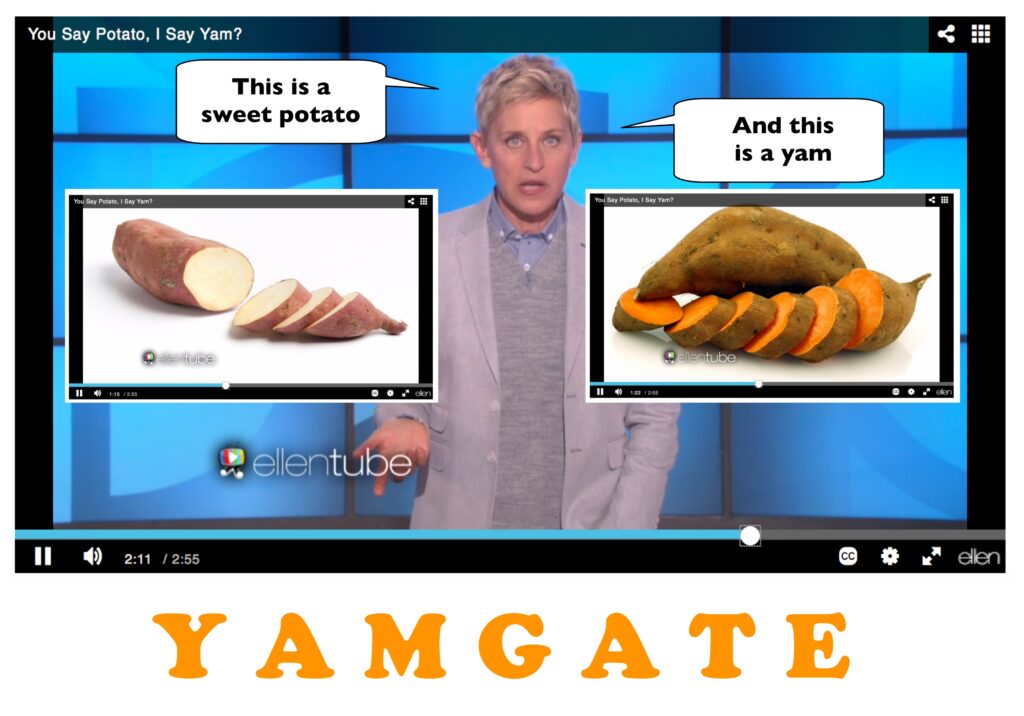This page is for people arguing over the difference between yams and sweet potatoes. Most people in the United States are familiar with sweet potatoes, but yams (grown abroad, in hot places) are increasingly available at supermarkets so it’s important to know the difference in case you’re tasked with buying the right one for Thanksgiving. E.g., it would be bad if you came home with a big bag of yams when your spouse needed sweet potatoes. But before I get into the gruesome details, here’s a photograph showing several cultivars of sweet potatoes and a yellow yam.
There’s just one (1) species of sweet potato, Ipomoea batatas. It’s in the Convolvulaceae along with morning glories, and is a vine. But there are hundreds if not thousands of cultivars (varieties that are produced through selective breeding) that vary in skin color, flesh color, sugar content, and storage quality. Yams are in the Dioscoreacea (and are also vines, by the way), and there are several edible species. The two families are not closely related. To give you a sense of how different these two families are, the Convolulaceae are dicots and the Dioscoreaceae are monocots (grasses, etc.). In case you slept through biology class, monocots and dicots diverged some 200 million years ago. That’s a long period of time. And since you’re probably wondering, yams and sweet potatoes are not closely related to the potato (Solanum tuberosum), which is in the Solanaceae along with tomatoes and eggplants. To give you a visual sense of how all three are related, I marked their locations (below) on a family tree of plants made by the U.S. Botanical Garden.
If you have ignorant, argumentative family members, you could print this image and attach to your refrigerator so that everyone can see while cooking. Or print multiple copies onto 11 x 17″ paper, laminate, and then use as placemats. You can also be prepared by keeping a small version in your wallet in case the issue comes up at the grocery store.
One way to recognize an actual yam is by its large size. For example, look at the yams in the photograph below (by Jeff Haskins, for Global Crop Diversity Trust). It’s from a yam festival, presumably in the hours before things got really festive. Those are some nice looking yams, eh?
But yams can get much bigger. I found reports of a 304 lb yam in Fiji and a 606 lb one in India. 600 lbs is approximately the weight of a large vending machine, apparently (I had to look that up). Sweet potatoes rarely make the news in this way, except locally in places where sweet potatoes are grown. The current world record for a sweet potato seems to be just shy of 82 lbs, but you’ll never see anything that big in a store or even at a sweet potato festival. By the way, the heaviest potato is ~12 lbs, about the weight of a cat if you don’t overfeed it.
Another easy way to determine whether you have a sweet potato or yam is to look for oozing latex when you slice it (photo below), at least when they are relatively young. This is a fun party trick if you have a bunch of botany nerds around. Old sweet potatoes lack the latex, though. Sometimes you have to squeeze them to get the latex going.
And there are other differences. Sweet potatoes have smoother skin and usually are tapered at both ends.
You might not want to know, but the confusion about yams and sweet potatoes started because Europeans enslaved people from Western Africa. Yam (the word) is West African in origin (anyinam means yam; nyami means “to eat”).
When Africans were forcibly taken to areas planted with sweet potatoes, most likely the slaves called the sweet potatoes “yams” even though they weren’t. As a result, some varieties of sweet potatoes were sometimes called “yams” (e.g., see this book from 1900), especially in the South and especially in regards to sweet potato cultivars that were soft and extra sweet. These varieties were often given racist, offensive names that I really can’t repeat on this blog. The misnaming caused confusion early on, of course, since people knew they weren’t really yams. Indeed, I dug up a 1921 publication (The Sweet Potato: A Handbook for the Practical Grower) that advised that the habit of referring to sweet potatoes as yams “best be dropped.”
Unfortunately, in 1937, Louisiana embarked on a marketing scheme that involved labeling its sweet potatoes as “yams”. And that, folks, is why there’s such confusion today. Ellen is also to blame for perpetuating the problem. She’s from Louisiana.
The USDA eventually started to require that growers indicate, somewhere, that the contents are actually sweet potatoes. But growers and distributers usually shrink the font of the actual ingredient so that it’s not noticeable, or print the words on a side of the box that’s not typically displayed. Why do they try to hide that the box has sweet potatoes? The answer is that many (most?) Americans will pay more for something labeled as a yam. As a result, most U.S. citizens don’t know what a yam actually is. I wish the USDA would just ban the mislabeling.
Who cares? Allowing companies to label sweet potatoes as yams is like selling prunes as dried dates: both are sweet and chewy but are really different (again, dicot vs monocots). Moreover, mislabeled sweet potatoes are a health problem for people who are allergic to them. I’ve had people email me to say that, yes, they have this allergy and that mislabeling sweet potatoes truly puts them at risk of dying.

